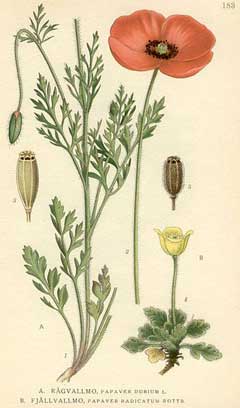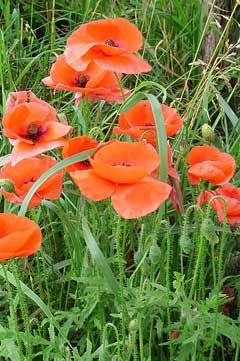 |
|
http://commons.wikimedia.org/wiki/File:Papaver_dubium_and_radicatum.jpg |
 |
| http://nl.wikipedia.org/wiki/Gebruiker:Rob_Hooft |
Translate this page:
Summary
Physical Characteristics

 Papaver dubium is a ANNUAL growing to 0.5 m (1ft 8in).
Papaver dubium is a ANNUAL growing to 0.5 m (1ft 8in).
See above for USDA hardiness. It is hardy to UK zone 7. It is in flower from June to July, and the seeds ripen from August to September. The species is hermaphrodite (has both male and female organs) and is pollinated by Bees, flies, beetles. The plant is self-fertile.
Suitable for: light (sandy), medium (loamy) and heavy (clay) soils, prefers well-drained soil and can grow in nutritionally poor soil. Suitable pH: mildly acid, neutral and basic (mildly alkaline) soils. It cannot grow in the shade. It prefers moist soil.
UK Hardiness Map
US Hardiness Map
Synonyms
Plant Habitats
Cultivated Beds;
Edible Uses
References More on Edible Uses
Medicinal Uses
Plants For A Future can not take any responsibility for any adverse effects from the use of plants. Always seek advice from a professional before using a plant medicinally.
Diaphoretic
The plant is sudorific[240].
References More on Medicinal Uses
The Bookshop: Edible Plant Books
Our Latest books on Perennial Plants For Food Forests and Permaculture Gardens in paperback or digital formats.

Edible Tropical Plants
Food Forest Plants for Hotter Conditions: 250+ Plants For Tropical Food Forests & Permaculture Gardens.
More

Edible Temperate Plants
Plants for Your Food Forest: 500 Plants for Temperate Food Forests & Permaculture Gardens.
More

More Books
PFAF have eight books available in paperback and digital formats. Browse the shop for more information.
Shop Now
Other Uses
References More on Other Uses
Cultivation details
Prefers a well-drained sandy loam in a sunny position[1, 200]. Does not do well on wet clay soils but succeeds in most other soils[115]. This species is possibly more tolerant of poor soils than P. rhoeas[17]. Plants usually self-sow freely when growing in suitable conditions so long as the soil surface is disturbed[238]. When growing in cereal fields, poppies decrease the yields of nearby cereal plants[18, 20]. Members of this genus are rarely if ever troubled by browsing deer or rabbits[233].
References Carbon Farming Information and Carbon Sequestration Information
Temperature Converter
Type a value in the Celsius field to convert the value to Fahrenheit:
Fahrenheit:
The PFAF Bookshop
Plants For A Future have a number of books available in paperback and digital form. Book titles include Edible Plants, Edible Perennials, Edible Trees,Edible Shrubs, Woodland Gardening, and Temperate Food Forest Plants. Our new book is Food Forest Plants For Hotter Conditions (Tropical and Sub-Tropical).
Shop Now
Plant Propagation
Seed - sow spring in situ[200].
Other Names
If available other names are mentioned here
Native Range
TEMPERATE ASIA: Afghanistan, Cyprus, Egypt (Sinai), Iran, Iraq, Turkey, Russian Federation-Ciscaucasia (Ciscaucasia), Armenia, Azerbaijan, Georgia, Russian Federation (Dagestan) TROPICAL ASIA: Pakistan EUROPE: Denmark, United Kingdom, Ireland, Sweden (south), Austria, Belgium, Switzerland, Germany, Hungary, Netherlands, Poland, Slovakia, Belarus, Estonia, Lithuania, Latvia, Moldova, Ukraine (incl. Krym), Albania, Bulgaria, Bosnia and Herzegovina, Greece, Croatia, Italy (incl. Sardinia, Sicily), North Macedonia, Montenegro, Romania, Serbia, Slovenia, Spain (incl. Baleares), France (incl. Corsica), Portugal AFRICA: Spain (Canarias), Portugal (Madeira Islands), Algeria (north), Egypt, Libya (north), Morocco, Tunisia
Weed Potential
Right plant wrong place. We are currently updating this section.
Please note that a plant may be invasive in one area but may not in your area so it's worth checking.
Conservation Status
IUCN Red List of Threatened Plants Status :

| Related Plants
|
| Latin Name | Common Name | Habit | Height | Hardiness | Growth | Soil | Shade | Moisture | Edible | Medicinal | Other |
| Argemone albiflora | White Prickly Poppy, Bluestem pricklypoppy | Annual | 1.5 |
6-9
| | L | N | DM | 0 | 1 | |
| Argemone mexicana | Prickly Poppy, Mexican pricklypoppy | Perennial | 0.6 |
7-10
| | L | N | DM | 1 | 3 | 2 |
| Chelidonium majus | Greater Celandine, Swallow Wort, Greater Celandine | Perennial | 0.5 |
5-8
| F | LMH | FSN | M | 1 | 3 | 2 |
| Corydalis ambigua | | Perennial | 0.2 |
5-9
| | LM | S | M | 1 | 3 | |
| Corydalis aurea | Scrambled Eggs | Annual/Biennial | 0.5 |
5-9
| | LM | S | M | 0 | 2 | |
| Corydalis cava | | Perennial | 0.2 |
5-9
| | LM | S | M | 0 | 3 | |
| Corydalis edulis | | Perennial | 0.0 |
-
| | LM | S | M | 1 | 0 | |
| Corydalis falconeri | | Perennial | 0.0 |
-
| | LM | S | M | 0 | 0 | 1 |
| Corydalis govaniana | | Perennial | 0.0 |
-
| | LM | SN | M | 0 | 2 | |
| Corydalis incisa | Incised fumewort | Annual/Biennial | 0.3 |
6-10
| | LM | S | M | 1 | 1 | 0 |
| Corydalis intermedia | | Perennial | 0.2 |
-
| | LM | S | M | 0 | 1 | |
| Corydalis juncea | | Perennial | 0.0 |
-
| | LM | SN | M | 1 | 0 | |
| Corydalis ochotensis | | Biennial | 1.0 |
-
| | LM | SN | M | 1 | 0 | |
| Corydalis pallida | | Biennial | 0.3 |
-
| | LM | SN | M | 1 | 0 | |
| Corydalis solida | Fumewort, Spring fumewort | Perennial | 0.2 |
5-9
| | LM | S | M | 1 | 3 | |
| Corydalis ternata | Three-Leaf Corydalis | Perennial | 0.2 |
-
| | LM | SN | M | 0 | 2 | |
| Corydalis vaginans | | Annual/Biennial | 0.0 |
4-8
| | LM | SN | M | 0 | 1 | |
| Corydalis yanhusuo | Yan Hu Suo | Perennial | 0.0 |
-
| | LM | SN | M | 0 | 3 | |
| Dicentra canadensis | Squirrel Corn | Perennial | 0.2 |
4-8
| | LM | FS | M | 1 | 2 | |
| Dicentra cucullaria | Dutchman's Breeches | Perennial | 0.1 |
5-9
| M | LM | FS | M | 0 | 2 | |
| Dicentra eximia | Dwarf bleeding heart, turkey-corn | Perennial | 0.4 |
3-9
| M | LMH | FS | M | 0 | 0 | 4 |
| Dicentra spectabilis | Bleeding Heart, Japanese Bleeding Heart, Common Bleeding Heart | Perennial | 0.6 |
3-9
| M | LM | SN | M | 1 | 0 | |
| Eschscholzia californica | Californian Poppy | Perennial | 0.3 |
6-11
| F | LMH | N | DM | 1 | 3 | 2 |
| Glaucium flavum | Horned Poppy, Yellow hornpoppy | Perennial | 0.6 |
6-9
| S | LMH | N | DM | 2 | 1 | 2 |
| Macleaya cordata | Plume Poppy | Perennial | 2.0 |
4-10
| F | LMH | SN | M | 0 | 1 | 1 |
| Meconopsis aculeata | | Perennial | 0.6 |
6-9
| | LMH | S | M | 1 | 2 | |
| Meconopsis grandis | Blue Poppy | Perennial | 1.0 |
4-8
| | LMH | S | M | 1 | 0 | |
| Meconopsis napaulensis | Himalayan Poppy | Perennial | 2.0 |
7-10
| | LMH | S | M | 1 | 1 | |
| Papaver argemone | Prickly Poppy, Long pricklyhead poppy | Annual | 0.4 |
7-10
| | LMH | N | M | 0 | 1 | |
|
|
Growth: S = slow M = medium F = fast. Soil: L = light (sandy) M = medium H = heavy (clay). pH: A = acid N = neutral B = basic (alkaline). Shade: F = full shade S = semi-shade N = no shade. Moisture: D = dry M = Moist We = wet Wa = water.
Now available:
Food Forest Plants for Mediterranean Conditions
350+ Perennial Plants For Mediterranean and Drier Food Forests and Permaculture Gardens.
[Paperback and eBook]
This is the third in Plants For A Future's series of plant guides for food forests tailored to
specific climate zones. Following volumes on temperate and tropical ecosystems, this book focuses
on species suited to Mediterranean conditions—regions with hot, dry summers and cool, wet winters,
often facing the added challenge of climate change.
Read More
Expert comment
Author
L.
Botanical References
17200
Links / References
For a list of references used on this page please go here
Readers comment
| Add a comment |
|
If you have important information about this plant that may help other users please add a comment or link below. Only comments or links that are felt to be directly relevant to a plant will be included. If you think a comment/link or information contained on this page is inaccurate or misleading we would welcome your feedback at [email protected]. If you have questions about a plant please use the Forum on this website as we do not have the resources to answer questions ourselves.
* Please note: the comments by website users are not necessarily those held by PFAF and may give misleading or inaccurate information.
To leave a comment please Register or login here All comments need to be approved so will not appear immediately.
|
|